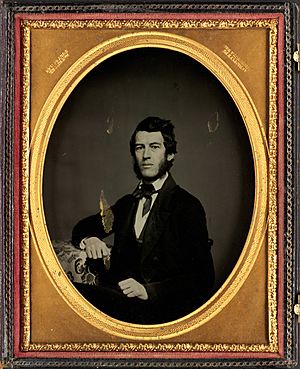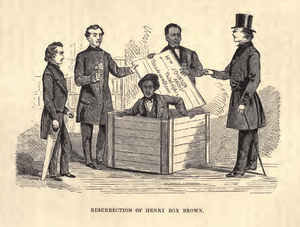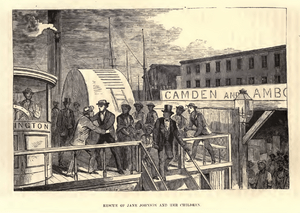Passmore Williamson facts for kids
Passmore Williamson (born February 23, 1822 – died February 1, 1895) was an American abolitionist and businessman. He lived in Philadelphia, Pennsylvania, which was a free state. Williamson was the secretary of the Pennsylvania Anti-Slavery Society. He is best known for helping Jane Johnson and her two sons become free from slavery in 1855.
In a famous court case, a judge ordered Williamson to bring Jane Johnson and her sons to court. This was under the Fugitive Slave Law of 1850. Williamson did not know where they were, so he could not bring them. The judge then sent him to jail for 90 days.
Williamson's jailing made his case very famous. It started a big discussion about how much power the "Slave Power" had over state laws. Pennsylvania law said that if slave owners brought enslaved people into the state, those people could choose to be free. Jane Johnson was not a "fugitive" because she became free when she entered Pennsylvania.
Contents
Early Life and Work
Passmore Williamson was born in 1822. His parents, Thomas and Elizabeth Williamson, were part of the Quaker faith. He grew up in Westtown, Pennsylvania. In the 1840s, his family moved to Philadelphia. Like his father, Passmore became a conveyancer. This job involved preparing legal papers for property, such as deeds.
As an adult, he became very dedicated to abolitionism. This was the movement to end slavery. In 1842, he joined the Pennsylvania Abolition Society. He became its Secretary in 1848. Pennsylvania was a free state. It did not allow slavery. The state believed that slave owners gave up their rights to enslaved people if they brought them into Pennsylvania.
Family Life
In 1848, Williamson was removed from the Quaker group. This happened because he was a very strong abolitionist and did not attend meetings often. Later that year, he married Mercie Knowles Taylor. They had a Quaker wedding. They had four children together, two girls and two boys. Their youngest son was named Sumner. This was to honor Charles Sumner, a US Senator who supported Williamson in the Jane Johnson case.
Fighting Against Slavery
Williamson also joined the Pennsylvania Anti-Slavery Society. This group was more radical and had both Black and white members. He was part of its Vigilance Committee. This committee helped enslaved people who had escaped. They also resisted the Fugitive Slave Act after it was passed in 1850.
In 1852, Williamson and the Pennsylvania Anti-Slavery Society helped defend men. These men were involved in the Christiana Riot. In this event, some Black men tried to stop the capture of four enslaved people from Maryland.
Henry "Box" Brown's Escape
The Pennsylvania Anti-Slavery Society helped Henry Box Brown escape slavery. Henry was an enslaved clerk in Virginia. On March 23, 1849, he arranged to be mailed in a wooden crate. The crate was sent by a private delivery service to Williamson's office in Philadelphia. The next day, Williamson, William Still, and other members of the Society opened the crate. Henry "Box" Brown stepped out, free.
Helping Jane Johnson Gain Freedom
Williamson played a key role in helping Jane Johnson and her two sons become free. Her sons were Daniel (about 5-6 years old) and Isaiah (about 11-12 years old). Their owner, John Hill Wheeler, was a US Minister to Nicaragua. He was traveling from Washington, D.C., to New York City. He planned to take a ship to South America.
On July 18, 1855, their train arrived in Philadelphia. Wheeler bought tickets for a steamboat to New York. He locked Johnson and her sons in a hotel room while his family explored Philadelphia. Jane Johnson's oldest son had been sold away from her. She was determined that she and her younger sons would be free. She asked a Black porter for help through the locked door. The porter contacted William Still. Still was a member of the Pennsylvania Anti-Slavery Society.
Still quickly told Williamson. The two men rushed to the docks. Wheeler, his family, and Johnson and her sons were getting on the steamboat. Williamson told Johnson and Wheeler that Pennsylvania law did not allow slavery. He said she was free to leave Wheeler if she chose. As she and her sons walked away with Still, five Black deckhands helped stop Wheeler. He tried to prevent her from leaving.
Wheeler asked a judge, John K. Kane, for help. The judge ordered Williamson to bring Johnson and her sons to court. Still and the five deckhands were later accused of taking Johnson by force.
Judge Kane charged Williamson with not obeying the court. Williamson truly did not know where Johnson and her children were. This was a common practice to protect people. Williamson argued that Johnson was not a "fugitive slave." Wheeler had brought her into Pennsylvania voluntarily. In Pennsylvania, she had the right to choose freedom.
Judge Kane said Williamson had broken the Fugitive Slave Law of 1850. This law said that even people in free states had to help return enslaved people. The judge ignored a statement from Jane Johnson. She said she had not been forced to leave. Many people were angry because they felt Judge Kane was making the Fugitive Slave Act too powerful.
Williamson spent 100 days in Moyamensing Prison. This was from July 27 to November 3, 1855. His case was in many newspapers. People sent him letters and visited him. Famous abolitionists like Frederick Douglass and Harriet Tubman visited him. His imprisonment helped the abolitionist cause a lot.
On August 29, 1855, Still and the five deckhands went to trial. Jane Johnson and her sons were living in New York by then. She came back for the trial. She wore a veil to hide her identity. She testified that Still had not forced her. She had planned to gain freedom for a long time. Her testimony helped Still and three of the men be found not guilty. The other two men received lighter sentences.
Jane Johnson was quickly taken out of the city. She avoided federal officers. She and her children remained free. They moved to Boston and settled there. Jane married and worked as a seamstress. Her son Isaiah Johnson later served in the United States Colored Troops during the American Civil War.
Williamson tried to get out of prison by saying he was held illegally. But his request was denied. He was finally freed on November 3. He later sued Judge Kane for illegal imprisonment. The case was still ongoing when Judge Kane died in 1858.
Later Life
Williamson continued to be involved in fighting for rights. He supported voting rights for women early on.
His wife, Mercie, died in 1878. Passmore Williamson died years later. He was buried next to his wife and father in a Quaker cemetery in Upper Darby, Pennsylvania.
Images for kids







